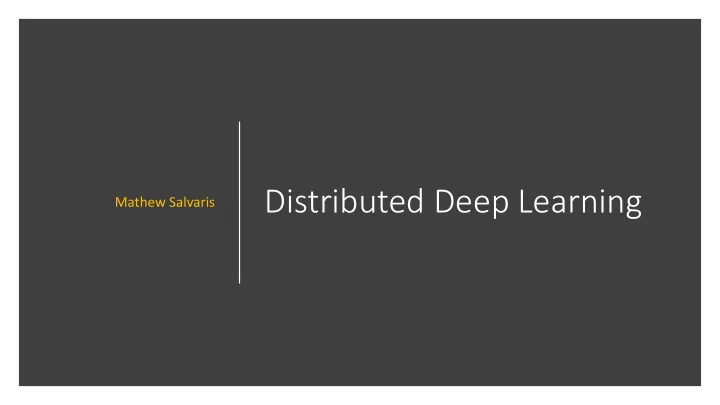

Distributed Deep Learning Mathew Salvaris
What will be covered • Overview of Distributed Training • What affects distributed training • Network • Model • Data location • Data format
Deep Learning Model (CNN) penultimate layer Cat Dog Mouse RGB Channels Convolution layer Pooling layer Fully connected layer of input image with Kernels
Distributed training mode: Data parallelism Worker 1 Worker 2 Job manager CNN model Subset 1 CNN model CNN model Subset 2 Dataset
Distributed training mode: Model parallelism Worker 1 Worker 2 Job manager CNN model CNN model Subset 1 Subset 1 CNN model Dataset
Data parallelism vs model parallelism Data parallelism Model parallelism • Easier implementation • Better scalability of large models • Less memory on each GPU • Stronger fault tolerance • Higher cluster utilization
Horovod: Ring All Reduce
Effects of Network, Model and Precision
Clusters of 8 nodes using K80 , P40 , P100 and V100 (4 GPUs per node+Infiniband) Two MPI configurations OpenMPI+NCCL and IntelMPI Setup
345 experiments across many different models including ResNet50 , MobileNet V2 etc. Using synthetic data Batch size remains 64 across all models and GPUs Use the benchmarking scripts from TensorFlow Experiments
Distributed training with synthetic data Compute Pool I A I
Single GPU Mathew Salvaris @msalvaris
32 GPUs
32 GPUs Mathew Salvaris @msalvaris
MobileNet Mathew Salvaris @msalvaris
MobileNet Mathew Salvaris @msalvaris
GPU K80 P40 P100 V100 Time it takes to process batch on GPU Batch Execution Time it takes to transfer weights Data Transfer between GPUs
ResNet50 Full Precision vs Mixed Precision [32 V100s] 90 25000 23,436 80 82 20000 70 60 SCALING EFFICIENCY 54 15000 IMAGES/SECOND 50 40 10000 30 6,629 20 5000 10 0 0 Full precision[64] Mixed precision [256] Images/second Scaling efficiency
Effects of Storage
Using ResNet50 across three frameworks [PyTorch, TensorFlow, Keras] Using real and synthetic data. Real data on local, NFS and Blob storage Batch size remains 64 across all configurations Uses V100 GPUs Experiments
Distributed training with NFS Copy Data Compute Pool NFS I Share A I Mounted Fileshare
Distributed training with blob storage Copy Data Compute Pool Mounted I Blob A I Mounted Fileshare
Distributed training with local storage Copy Data Compute Pool I A I Mounted Fileshare
ResNet50 - Relative performance across storage 1 0.8 0.6 0.4 0.2 0 TensorFlow Keras PyTorch Synthetic Local(SSD) NFS Premium Blob Blob
Data Loaders and Preprocessors Keras Data Loader PyTorch Data Loader Simple with no parameters for buffering and Specify number of workers with num_workers parallelizing
Highly configurable Many options : buffer, shuffle, cache TensorFlow and shard Daunting and easy to get wrong https://www.tensorflow.org/guide/performance/datasets
Effects of Data Type
TensorFlow Records • Binary data format created for TensorFlow – Recommended format for TensorFlow • Can aggregate number of examples to smaller number of TFRecords – efficient for transferring and reading in the cloud • Have to export data to format - Has to be tailored to use case
ResNet50 – Data Type Performance [Average] 7,000 6,000 5,000 AVERAGE IMAGES/SECOND 4,000 3,000 2,000 1,000 0 8 16 32 Synthetic Images TFRecords
ResNet50 – Data Format Performance [Maximum] 7,000 6,000 5,000 MAXIMUM IMAGES/SECOND 4,000 3,000 2,000 1,000 0 8 16 32 Synthetic Images TFRecords
Asynchronous distributed training Tradeoff between batch size and other parameters Optimization of TensorFlow pipeline Things not Other data formats such as Parquet (Petastorm) discussed Transform libraries [albumentations] Distributed file systems BeeGFs and other storage GlusterFS, Lustre etc. Models other than CNN
Do try to use enhanced networking wherever possible especially for the latest GPUs Training small models using distributed training is not recommended Summary Do use TFRecords or other columnar or row based data formats Not all data loaders are equal
Thanks & Questions?
Recommend
More recommend